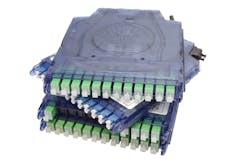Adjusting the supply chain to a new and improved normal
Having made such adjustments, our outlook on 2023 is fairly good, considering many aspects of the supply chain from raw material availability through make and finish for the products that we manufacture. To clarify, fiber itself wasn’t the problem. The material used to jacket it includes basic components widely used across different industries, like the automotive industry that typically took priority over other manufacturers.
Materials madness
The biggest significant materials shortage that impacted Clearfield and many other companies’ operations was in polyvinylidene fluoride (PVDF), a specialty plastic we used in indoor/outdoor fire-rated cable. PVDF, solely manufactured by BASF, is used in a variety of industries to make everything from chipsets to batteries. The automotive industry has priority due to the large quantities it buys.
Challenges in getting cable persisted in 2021 and 2022, leading to our decision to expand our supply base to multiple manufacturers in order to meet demand. While we did not see issues with the availability of sheet metal supplies such as steel and aluminum, the prices kept going up. Today, we’re observing sheet metal pricing beginning to trickle downward.
The pandemic left many scrambling to keep stock in raw materials with shortages having ripple effects across the industry. For example, helium, used in the manufacture of different polymers, was in a worldwide shortage for approximately six months. To overcome these challenges, we had to constantly pivot, buying overstock or stock no one else had found.
When Clearfield ran into shortages of materials, such as PVDF, we prioritized our contract customers with which we had agreements for maintaining a certain amount of product. After that, we allocated everything we had available to our customers. In cases where we could not provide 100% fulfillment for demand, we worked with them to offer alternatives that met their build schedules. For example, we were able to offer other types of flame-rated cable like low-smoke zero-halogen materials or other media when PVDF-based products weren’t available.
Import/export challenges
The availability of freight was a challenge, with the whole transportation industry having an impact upon our ability to get raw materials and to get products to customers. Anything coming in a container was delayed or got stuck in a port. We hired an experienced import/export professional, who knew how to route traffic a little differently to get things into ports that were closer to our manufacturing facilities. Once the ports started to fix themselves, the next task was to get containers on the rail to be shipped.
From a sourcing perspective, procurement needs to be involved in the development process, so we aren’t over-customizing the hardware we use. We provide a 24-inch-long screwdriver used to put cassettes into our cabinets. At one point we were almost out of stock of these screwdrivers, because demand for cabinets increased and we had not anticipated having any difficulty sourcing a 24-inch screwdriver. But it is a custom-made screwdriver, not one that can be found on the shelf.
When we were running low on one type of injected mold plastic that we use in our cassettes—a building block in all our fiber-management products—we made plans to substitute a different color that was less desirable. The preferred plastic has a VO flame rating and is a blue translucent color, so you can red-light through the cassette and tell if there’s a broken fiber. We planned to substitute black PVT, which is opaque so you can’t see through it.
We made a big buy of the black PVT plastic on a contingency basis because we had to keep producing cassettes, and we were ready to announce to customers that we would be shifting to black, letting them know about the drawback to substituting-in black cassettes. Fortunately, our preferred translucent plastic supply improved, and we redirected the black PVT material for use in another component.
Clearfield’s experiences and actions during the pandemic have improved our processes and procedures going forward, to make sure we continue to build and deliver the quality products our customers need as the fiber industry and the world transition out of pandemic conditions and go back to a new normal.
Sourcing and procurement
We manage approximately 5,500 raw material part numbers. During the pandemic, we reviewed our entire supply chain. We are no longer single-sourcing any material or component today. Clearfield now uses two or more manufacturers for everything, from a screw costing half a penny to a PLC chip we source from overseas.
Our procurement department monitors the price of raw materials around the world and uses that data to make proactive decisions. For example, we're monitoring copper price indexes so if there’s an anticipated increase in raw copper out of different regions, we’ll look at other manufacturers that we may compete against for supply of the raw material and can act accordingly to proactively lock-in prices and find alternative suppliers as needed.
Since raw materials shortages have eased, our strategy has been to look into new ways of adding capacity to meet increased demand from fiber projects around the world. Our gating factor now has turned into workforce and labor minutes. One way to add capacity is taking subcomponents from our products we would traditionally manufacture in-house, and outsourcing them to trusted contract manufacturers. We can then leverage our existing workforce and continue to control quality by bringing those subcomponents in-house for final assembly and testing at a Clearfield facility to create finished products.
In anticipation of the continued growth in the fiber market, we've continued to develop our strategy of expanding our facilities and workforce to ensure on-time customer deliveries. In March 2022, we added a 330,000-square-foot facility in Mexico, and we anticipate adding further space in the future as we look to begin optical fiber production in North American in early 2023. To further these initiatives, in July 2022 we completed the acquisition of Nestor Cables, a leading European developer and manufacturer of fiber-optic cable solutions, adding two production facilities and enabling us to vertically integrate the supply of Clearfield’s fiber-optic cables to meet future customer demand. We also continue to add to the direct head count of our workforce in the United States and around the world.
Transportation and shipping issues continue to get better, between the ability to redirect shipments to less-congested ports and the overall recovery of the commercial maritime shipping industry. West Coast ports no longer have lines of ships waiting to be unloaded and containers are now flowing more easily from the docks onto rail and trucks.
In summary, Clearfield and other manufacturers have adapted to the shocks, shortages, and delays introduced worldwide with the onset of the pandemic in the spring of 2020. We have diversified our supply chains to be more agile to adapt to market conditions and avoid single-point failures by being dependent on a single supplier. Today, we’re gearing up to increase supply to meet the needs of the next five years as fiber network projects around the globe move into high gear.
About the Author

Johnny Hill
Johnny Hill is a founding member of Clearfield and has been the company’s chief operating officer since 2008. His leadership in building the operational organization enabled doubling the size of manufacturing operations to support explosive company growth.
Hill has approximately 25 years of strategic and hands-on experience in the telecommunications networking industry. He started his career at Americable Inc. in 1996. He was national sales manager when the company was acquired by Clearfield’s precursor, APA Cables & Networks in 2003. From 2006 to 2008, Hill served as Clearfield’s vice president of product management and development, and vice president of engineering and product management until being appointed COO in 2008.
During his career, Hill has amassed many U.S. patents, building a national reputation within the telecommunications industry on such issues as fiber management, harsh environments, network design and transport, fiber and copper assemblies, network security, premises network equipment, and structured wiring among others.

